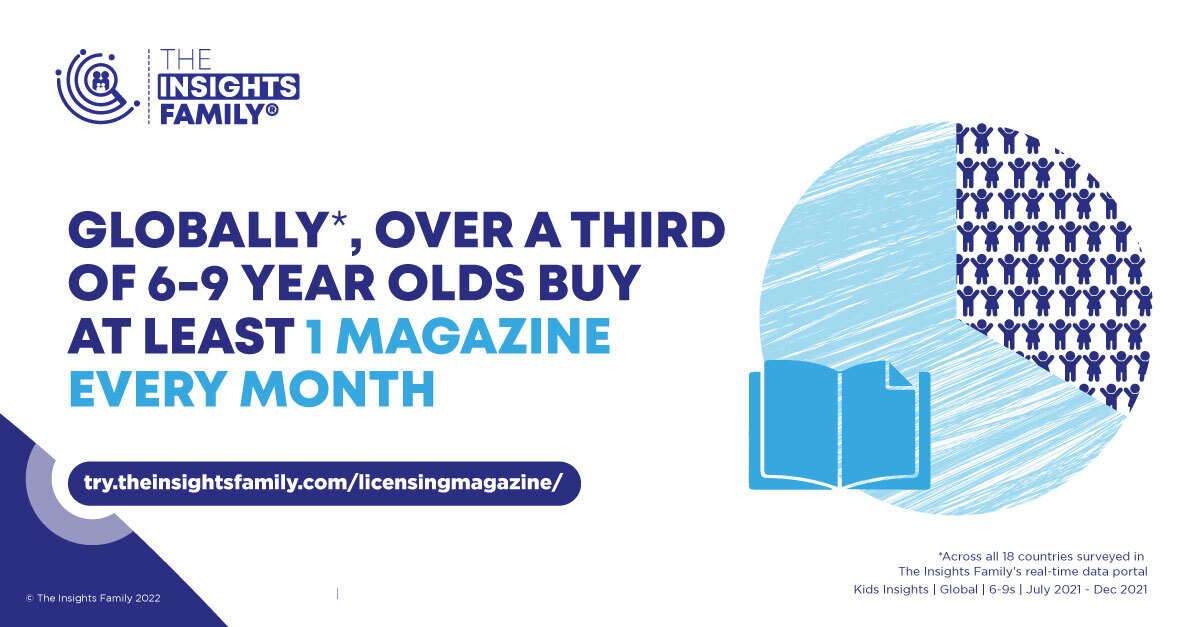
Get the latest updates in your inbox and sign up for more info!
The Bologna Licensing Trade Fair / Kids, dedicated to licensing and entertainment, takes place from 21 to 24 March 2022, as an integral part of Bologna Children's Bookfair. In particular, the International Kids Licensing Day, held on 21 March in hybrid digital and in-person mode, explores trends and data from the world of kids.And there are interesting surprises: even though children have an increasingly digitized life, they continue to devote a big part of time to offline hobbies such as reading, also thanks to the encouragement of parents. This article originally published in Italian and English on Licensing Magazine 2/2022 examines the importance that magazines can assume for the age group 6-12, and the ways in which entertainment brands can incentivize their purchase.
In the last 5 years, we have seen how digital device ownership and access has increased amongst kids aged 6-12 in Europe, with 3 in 5 kids of this demographic in the UK now owning their own tablet.

In tandem, we are seeing that kids are increasingly choosing digital hobbies – gaming, coding, social media – and aspiring to digital careers. With new interest come new trends and we are all no doubt having meeting after meeting about the rise of the metaverse and what this means for our respective brands.
That said, brands should not underestimate the importance of a far-reaching offline ecosystem. Kids’ lives are increasingly lived in a combination of interconnected digital worlds and as pandemic restrictions ease and summer approaches, we predict that offline hobbies and interests will retain popularity. Furthermore 83% of parents across the markets which we cover, agree that they would like their kids to occupy the online and offline worlds equally. That is why I think magazines are perfectly positioned to provide kids with interactive, educational content which they can not only consume but also co-create. In Europe, over a third of 6-9 year olds buy at least 1 magazine every month. What’s more, this number has increased year-on-year from 2021 to 2022 in France (+11%), Germany (+7%) and the UK (+6%).
A free gift is the number one driving factor behind magazine purchases globally amongst 6-9s. However whilst remaining important, in recent years this factor has become less significant - it has fallen across the last year amongst 6-9 year olds in Brazil (-8%), the US (-8%), China (-12%), India (-18%) and Russia (-18%). The Insights Family data suggests that this is due to a multitude of reasons, which the rise in environmental concerns amongst kids over the last few years being a key driver. Amongst 6-9s in Italy surveyed between July and December 2021, those who are concerned about climate change and the environment are -15% likely than the average kid their age to select a magazine based on a free gift, indicating that those who are aware of this topical issue are acting upon it, attempting to mitigate their carbon footprint through a reduction in the consumption of single-use plastics. Brands can therefore target this demographic through the promotion of eco-friendly gifts, such as non-plastic ones, which could become their USP. Furthermore, should brands forgo the use of free gifts altogether, utilising recycled materials in the production of reading material is a way to engage with this increasingly eco-conscious generation.
If kids are increasingly less motivated to purchase a magazine for its free gift, it seems as though the popularity of magazines is being driven by attraction to characters, IPs and franchises. There is less need for physical possessions to drive purchase behaviour, meaning that the content itself is what kids are interested in when selecting a magazine. This is illustrated in our data - for 3-5 year olds, the importance of content in this space has increased year-on-year in the UK (+20%), Russia (+26%) and Italy (+31%), when comparing Jan-June 2021 with July-Dec of the same year. In a fragmented space such as the kid’s ecosystem, where there are numerous platforms and media types fighting for attention at any given time, it is crucial for quality content to stand out from the crowd.
Breaking through the noise and congestion of a saturated marketplace becomes much easier through recognisable imagery and popular IPs in the kid’s space. Kids recognising their favourite IP in alternate touchpoints gives a product a better opportunity to resonate with them. Favourite character ranks as the second main reason for buying a magazine, showing the demand amongst kids for offline engagement with their preferred IPs. Licensed magazines dominate the most purchased magazines amongst kids in Europe, with global brands Pokémon and Fortnite leading the way and 4 LEGO titles appearing in the top ten. For 3–5-year-olds surveyed between July and December 2021, the favourite character as the main purchase reason has increased year-on-year in Italy (+11%), Germany (+13%) and the UK (+14%). This presents an opportunity for licensors to produce offline material in relation to kids' favourite characters.
Kids aged 6-12 in Europe are most likely to purchase a magazine related to their favourite TV show (21%), hinting at the importance of licensing products associated with a franchise. In the UK, this has increased by +38% over the last four months and is particularly amongst girls of this demographic. Amongst 6-9 year olds, Spider-Man and Elsa have topped the most popular character lists globally for boys and girls respectively over the last two years. Other Disney IPs appear in the top 5 for these characters, representing the significance the company has in the kids’ space - as such, Disney magazines appear in the top 5 most popular in the Philippines, Indonesia, South Korea, China, Italy, India, Spain and the US. The availability of a familiar touchpoint in the offline world clearly drives the purchase behaviour in this space, indicating that magazines represent an opportunity to engage with kids in the offline world.
As well as presenting a licensing opportunity, brands should look into advertising opportunities within the printed space, specifically in magazines. Since Q2 2021, the number of tweens and teens now reporting to trust advertisements ‘a lot’ has increased by +45%. Even though advertising in magazines seemed counterintuitive with the increased number of new technology and platforms that are constantly evolving and incorporating in kids’ lives, our Kids Insights Italy data shows otherwise. Italy has the highest number of tweens and teens reporting reading as their favourite hobby across European countries we survey. A significant push on advertising in the lead up to and during the Christmas period incites the need for brands to utilise offline advertising locations as a way of reaching kids. 6–12-year-olds who see their favourite advertisements in comics and magazines are more likely to talk about it with friends and families (+52%), be more interested in the product (+32%), and buy the products themselves (+34%), indicating the success of advertising in the magazine space. This further signifies the wide range of opportunities within the magazine space that brands can explore and diversify into.
As well as looking at advertising opportunities, brands need to understand their specific target audience, a one-size fits all approach does not work and is no longer fit for purpose. We are seeing how tweens and teens’ favourite IPs and characters - which can be examined closely from our IP INDEX™ tool - to be able to successfully collaborate with them to further increase reach and engagement from this demographic. Brands should maximize the marketing success by advertising in magazines while also utilizing the word-of-mouth strategy to encourage these tweens and teens to invite their friends to use the products for a trial of the products or discounts for future purchases.
By Nick Richardson, Founder & CEO, The Insights Family
The Insights Family is the global leader in kids, parents, and family market intelligence, providing real-time data on their attitudes, behaviour, and consumption patterns.
Kids Insights surveys 7,780 children every week aged 3-18. Parents Insights surveys more than 3,800 parents of children between the ages of 1 and 16 every week. Both services operate in 22 countries across six continents and in total survey more than 469,040 kids and 228,800 parents a year. This means that the company interviews a new family member somewhere in the world every 45 seconds.
The Insights Family produced an exclusive “2022 Toy Report: The Year of STEM” for London Toy Fair, the UK’s largest dedicated toy, games and hobby trade show in January 2022. Sign up to receive your free copy here: try.theinsightsfamily.com/licensingmagazine